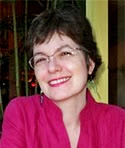Being new, young, and untrained, I had been given an interior cubicle at some distance from the rest of the Harmony people. Meetings happened and all too often nobody remembered to call and invite me (pre-email!) because in my distant cell I was a forgotten prisoner of paste-up.
Luckily I sat near a team of incredibly talented women who produced the luscious promotional materials that helped sell all the Crown books in bookstores and book fairs as well as glossy ads, mailers, posters, book stands, special gifts, and cool give-aways. Whenever I had a free moment I would wander over and watch or ask if they needed any help. Arlene Boehm and Nancy Hussar* had major chops. Nancy, always preppy looking, brought a sort of ultra Martha Stewart level of taste and class to anything she touched--she loved antiques and interior design. Arlene was a cockatiel loving tall thin red-head who arrived at work on motorcycles and had a passion for pre-Raphaelite art. She kept a wonderfully illustrated journal of her adventures, with bears as her avatars. I LOVED them. They took pity on me.
Arlene told me to take as many calligraphy classes as possible, "take italic, roman, uncial, anything," that in this way I would really begin to understand type and one couldn't design well without understanding type. This was the best advice about learning design that I have ever gotten. Ever. I took classes through The New School, many from the legendary Jeanyee Wong. In those classes, gripping a pen with a square cut metal nib and dipping it in ink, I learned why type is thick and thin and how size of nib, angle, and pressure made the letters take on different personalities. Most of all, I realized that tight effort in my fingers was less effective than a fluid gesture that involved my entire arm, and soon, my whole body including my breath. The dancers got it right away, they were used to kinetic expression, if the line was moved from stage to page, it was still a narrative movement.
Some of the dancers were recently retired, some were on injury hiatus, I'd look at their poise and beautiful results and just pretend I too could dance in ink.
My calligraphy did help me to see how typefaces differ and also gave me a new appreciation of the incised letters in ancient Roman arches, those too were made with calligraphic shapes, and I loved looking at Islamic, Medieval, and Chinese hand lettering at the Morgan Library. I loved calligraphy but... it wasn't going to be my career. It could have been, and people that started when I did are these many years later true masters of the craft. But I loved designing books.
Graphic design moved from originating on paper to originating on computers. I learned it as it happened. I work on a computer now. It isn't physically kinetic like calligraphy and I miss that. Don Pettit, the astronaut, described typing on a laptop in weightlessness and realizing that with no "top" or "bottom" there doesn't need to be a desk tethered to a wall. He could float anywhere and work, all he needed was a way to keep additional materials traveling with him. What a thought. Everything in page design responds to our human bias to "feel" gravity. Think about it, when I center a block of type on a page it feels better to have a little more space below than above, this has something to do with how we see things in perspective as we walk on the ground, held there by gravity. When roman architects made columns they made the bases thicker than the tops, again because of perspective, things with bases that are thicker feel more stable. How will designing in weightlessness affect design in the far future? Will the golden rule travel like cultural DNA into space? I suspect it won't. Look how Twitter and blogs and websites are affecting print design. Change, change, change. Dance, dance, dance.
*Sadly, Nancy died a few years ago, too soon. She is missed... Arlene designs, paints, and has illustrated her own picture books.







No comments:
Post a Comment